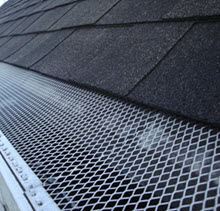Tasks on both the inside and outside of your home for the season.
 Roof
Roof - it is best that the roof be inspected before it gets too hot, both on the roof surface and in the attic if it must be accessed.
The gable vents, at the inner attic, should have screening. Torn or breached screens should be replaced and this can be cut and usually stapled onsite.
Preventing insects and creatures from entering.
Gutters - the summer months are a good time to have gutter-screens or guards installed, after they have been cleaned.
Pruning/Landscaping - a lot of pruning can actually be avoided by waiting until the main growth spurt is over,
possibly early June for many types of plants and trees but this of course is based on the kinds on your property. It is vital that the outside AC compressor
have enough airflow and, for this, it might take some pruning. The compressor should also be checked for level and that there
are no obstructions around the intake.
Exterior Finishes - it's normally best to have any painting
done before the heat becomes too radical. This allows the paint to level-out
before drying (contrarily, drying agents accelerate dry-time and can cause lapping to occur). Also,
certain paints like some of the slow-dry solvent primers do require that the solution
dry at an effective crawl for successful top coating, for the coating not to crack. All
surfaces should be thoroughly dry especially when applying solvent based finishes - which can potentially trap moisture.
Decks - early summer is a fine time to clean and treat the deck if you have not already done so for the year. This gives wood decks a
chance to fully dry before staining or re-sealing.
Fencing - look at the entire fencing and also the end cuts. For split-rail fencing, pay particular attention to the post tops since these collect the
weather and have a tendency to begin to soften, and deterioate. These areas can be treated to help prolong the fence life. But you will have to determine whether staining or painting is necessary for appearance and function.
And some additional preparation might be called for, such as sanding by mechanical means.
Driveway/Pavement - patch any paving, and seal if it is called for - applying sealer when it is still warm and not too hot can
result in a more even layer. Cracks in concrete typically should have their joint cleared and sealed with a quality concrete filler.
Groundwork/Soil - keep in mind that any digging such as for plants or trenching like for running drains and lines is easier done before
some types of soil become too dry and hard. Just the right amount of moisture makes the job easier, though its not always possible.

 Roof - it is best that the roof be inspected before it gets too hot, both on the roof surface and in the attic if it must be accessed.
The gable vents, at the inner attic, should have screening. Torn or breached screens should be replaced and this can be cut and usually stapled onsite.
Preventing insects and creatures from entering.
Roof - it is best that the roof be inspected before it gets too hot, both on the roof surface and in the attic if it must be accessed.
The gable vents, at the inner attic, should have screening. Torn or breached screens should be replaced and this can be cut and usually stapled onsite.
Preventing insects and creatures from entering.